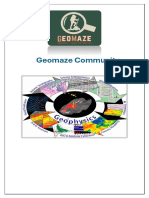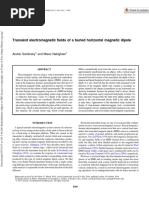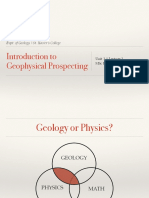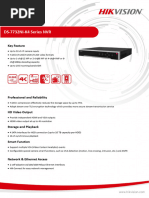NGA Groundwater
NGA Groundwater
Uploaded by
Waleed EjazCopyright:
Available Formats
NGA Groundwater
NGA Groundwater
Uploaded by
Waleed EjazCopyright
Available Formats
Share this document
Did you find this document useful?
Is this content inappropriate?
Copyright:
Available Formats
NGA Groundwater
NGA Groundwater
Uploaded by
Waleed EjazCopyright:
Available Formats
Geophysical Services Groundwater
Environmental • Groundwater • Geotechnical
Geophysical Services for The instruments are carried by one or two persons and
can cover a large area relatively quickly. However,
FDEM profiles provide only limited depth information.
GROUNDWATER
EXPLORATION Time-domain electromagnetic (TDEM) methods in
groundwater exploration are useful as sounding
techniques, as opposed to profiling techniques.
Geophysical methods can be very effective in the
Sounding techniques measure the depth to an interface,
search for groundwater resources. The appropriate or interfaces. They can be used to measure the thickness
geophysical program should be designed to meet of a gravel unit, depth and thickness of a clay aquitard,
the geological objective and the expected or depth to bedrock.
stratigraphic section. When combined with other
available geologic and borehole information In the most common groundwater exploration
geophysical data can refine the conceptual model configuration, TDEM soundings are made by laying
of the subsurface geology and provide additional out a loop of wire 20 to 200 feet on a side and pulsing
detail to the geologic interpretation. it with a controlled current. Measurements are made,
usually in the center of the loop, with an antenna coil
Several geophysical techniques are commonly applied about three feet across. All the equipment is easily
in the search for ground water. These include portable; six to sixteen soundings can be made in a
electromagnetic methods, both frequency-domain and day, depending on field conditions.
time-domain, seismic refraction, seismic reflection, (Continued Next Page)
and DC resistivity.
ELECTROMAGNETIC
METHODS:
Electromagnetic methods induce small
electrical currents in the ground. These
currents flow more readily in conductive
earth materials than in resistive strata.
Sand or gravel aquifers tend to be much
more resistive than silts and clays. By
studying the behavior of the electrical
currents in the ground we can deduce the
location of resistive strata (aquifers).
Frequency-domain electromagnetic
(FDEM) techniques are often used in a FIGURE 1: TDEM RESISTIVITY CONTOUR MAP
The resistivity contour plot shown above is from a time-domain
profiling mode to search for lateral electromagnetic (TDEM) survey over alluvial deposits in the Willamette Valley.
changes in soil conditions (e.g., mapping It shows the interpreted resistivity of a sand and gravel unit 20-30 meters in
the geometry of a gravel paleo-channel). thickness. The higher resistivity gravels are expected to have a lower
percentage of silt and clay, and hence a higher hydraulic transmissivity.
Northwest Geophysical Associates, Inc.
P.O. Box 1063, Corvallis, OR 97339-1063
(541) 757-7231 Fax: (541) 757-7331
www.nga.com info@nga.com
© 2000 Northwest Geophysical Associates, Inc.
Groundwater Page 2
SEISMIC REFRACTION ELECTRICAL (DC) RESISTIVITY:
and REFLECTION:
DC resistivity is one of the oldest and most well known
Seismic techniques use a small explosive or mechanical geophysical methods used in groundwater exploration.
energy source to impart a seismic pulse to the ground. This technique measures the electrical resistivity of the
The seismic waves travel through the soils to the ground, as do the EM techniques. Two-dimensional
bedrock or other competent layers below. There, the (2D) geology can be readily modeled with electrical
seismic waves are both reflected back to the surface resistivity data. However, DC resistivity generally has
and refracted along the bedrock surface for some lower resolution than the TDEM technique, both
distance before they return to the earth’s surface. vertically and horizontally.
Seismic Refraction is commonly used for engineering DC resistivity involves deploying long lengths of wire
and groundwater applications. The most common on the ground and injecting a DC current into the earth
objective is to map the bedrock surface (i.e., determine through a widely spaced pair of electrodes. The distance
the depth to bedrock, and variations in depth, along between current electrodes must be three or more times
the survey line). the intended depth of exploration. DC resistivity can
be an effective shallow sounding method. In general,
Seismic Reflection can provide higher resolution of electrical techniques are not well suited to developed
overburden stratigraphy and the bedrock surface, but areas due to interference from utilities, fences and
at substantially higher cost. The reflection technique structures.
involves acquiring more field data, and processing data
more intensively than seismic refraction. In some OTHER TECHNIQUES:
applications higher resolution may justify the higher
survey costs, depending on the expected geologic There are other geophysical techniques which can be
conditions and the objectives of the exploration used for groundwater exploration. These include
program. gravity, magnetics, controlled source audio
magneto-telluric (CSAMT), and “VLF”
150 150
EAST
techniques. NGA is familiar with these techniques
WEST
Geophone
Shotpoint
and has employed them on numerous projects. NGA
Positions Ground Surface
will recommend the most cost effective geophysical
5 7
140 1
4 6
140 methods to meet the geological objective in the
search for groundwater resources.
Elevation (feet)
Poorly Consolidated Soils
2260 ft/sec
130 130
Northwest Geophysical Associates, Inc.
(NGA) provides geophysical services for
groundwater exploration and development
Basaltic Bedrock including program design, field services, and
12,770 ft/sec 120
120
interpretation.
Vertical Exaggeration: 6x
0 50 100 150 200 250
Horizontal Distance (feet) FILE: Groundwater_Info02.p65
REVISION: 8-FEB-2002
FIGURE 2: SEISMIC REFRACTION PROFILE
© 2000 Northwest Geophysical Associates, Inc.
Northwest Geophysical Associates, Inc.
Geophysical Services
Environmental • Groundwater • Geotechnical
You might also like
- Geophysical Groundwater ExplorationDocument20 pagesGeophysical Groundwater ExplorationOtoma Orkaido50% (2)
- Application of Geophysical Methods in Agriculture: Reza Toushmalani Islamic Azad University, Hamedan BranchDocument7 pagesApplication of Geophysical Methods in Agriculture: Reza Toushmalani Islamic Azad University, Hamedan BranchDwi ApriyantoNo ratings yet
- Intern 2 Report Nguyễn Phan Hoàng Minh IELSIU18078Document47 pagesIntern 2 Report Nguyễn Phan Hoàng Minh IELSIU18078Thao PhamNo ratings yet
- Nga Tdem TeqDocument7 pagesNga Tdem TeqsandykerenzNo ratings yet
- College of Design, Art and Technology (CEDAT) Department of Civil and Environmental EngineeringDocument32 pagesCollege of Design, Art and Technology (CEDAT) Department of Civil and Environmental EngineeringshjahsjanshaNo ratings yet
- Enc Encoded L3 NgXolpznJnR2wqOt TCnhB03uDDGbDMidffy41YPlF3kgbJ8GO8nXHPCCDocument5 pagesEnc Encoded L3 NgXolpznJnR2wqOt TCnhB03uDDGbDMidffy41YPlF3kgbJ8GO8nXHPCCbharasha mahantaNo ratings yet
- Geophysical Methods: Presentation/LectureDocument53 pagesGeophysical Methods: Presentation/LectureAdam Sukma PutraNo ratings yet
- Geophysical and Geotechnical Surveys For Submarine Cables Installations: Main Applications and MethodsDocument5 pagesGeophysical and Geotechnical Surveys For Submarine Cables Installations: Main Applications and MethodslucioamaNo ratings yet
- 0208 AckmanDocument10 pages0208 AckmanetsimoNo ratings yet
- Jurnal 1 B IngDocument5 pagesJurnal 1 B Ingmr. XNo ratings yet
- Ground Penetrating Radar: Stephen Griffin and Timothy PippettDocument10 pagesGround Penetrating Radar: Stephen Griffin and Timothy PippettMojtaba TahaNo ratings yet
- Introduction To Geophysical MethodDocument15 pagesIntroduction To Geophysical MethodAmira OsamaNo ratings yet
- Presentation On Geophysical MethodsDocument8 pagesPresentation On Geophysical MethodsZanuraNo ratings yet
- Ajol-File-Journals 229 Articles 266564 660fd6d467eddDocument12 pagesAjol-File-Journals 229 Articles 266564 660fd6d467edd樱满恋No ratings yet
- Busch 2014Document12 pagesBusch 2014MárcioBarbozaNo ratings yet
- v67n3 El QadyDocument8 pagesv67n3 El QadyAstriNo ratings yet
- Geophysical Survey MethodsDocument5 pagesGeophysical Survey MethodsAlexander WilsonNo ratings yet
- Geophysics For The Mineral Exploration Geoscientist-1-4Document8 pagesGeophysics For The Mineral Exploration Geoscientist-1-4Fernando Payés VargasNo ratings yet
- Mesri and ShahienDocument19 pagesMesri and ShahienabdulqadirghoriNo ratings yet
- Use of Geophysical Methods For Soil Profile EvaluationDocument15 pagesUse of Geophysical Methods For Soil Profile EvaluationsafacevikNo ratings yet
- Week 1 (2) - Geophysical SurveyDocument34 pagesWeek 1 (2) - Geophysical SurveyMUSLIHAH AQILAH MUSAFFENDYNo ratings yet
- Nonsmooth Nonconvex Optimization For Low-Frequency Geosounding InversionDocument9 pagesNonsmooth Nonconvex Optimization For Low-Frequency Geosounding InversionHugoHidalgoNo ratings yet
- Nga Tdem Teq 3Document7 pagesNga Tdem Teq 3Gian Angga PratamaNo ratings yet
- Ground Penetrating Radar (GPR) : Dr. Ghulam Mohyuddin SohailDocument64 pagesGround Penetrating Radar (GPR) : Dr. Ghulam Mohyuddin SohailMuazNo ratings yet
- A Geophysical Approach For Mapping of Abandonned Mining Workings and Unconsolidated Zones in Coal Mining AreasDocument5 pagesA Geophysical Approach For Mapping of Abandonned Mining Workings and Unconsolidated Zones in Coal Mining Areasali.messaiNo ratings yet
- Survey Method SummariesDocument4 pagesSurvey Method Summariesvelkus2013No ratings yet
- Ground Penetrating Radar Interpretation As A Function of Soil Response Complexity in Utility MappingDocument10 pagesGround Penetrating Radar Interpretation As A Function of Soil Response Complexity in Utility MappingAnonymous 0qYv7WpgNo ratings yet
- 02 05 Ullrich Et Al Resistivity PDFDocument7 pages02 05 Ullrich Et Al Resistivity PDFYerkhaNo ratings yet
- Geophysics Ultimate ReviewerDocument6 pagesGeophysics Ultimate ReviewerNicole RodilNo ratings yet
- Petroleum GeophysicsDocument12 pagesPetroleum GeophysicsRyan PermanaNo ratings yet
- 783 3185 1 PBDocument9 pages783 3185 1 PBAlvaro Arley Cardona GutiérrezNo ratings yet
- Groundwater Investigation Using Geophysical Methods - A Case Study of Pydibhimavaram Industrial AreaDocument5 pagesGroundwater Investigation Using Geophysical Methods - A Case Study of Pydibhimavaram Industrial AreaInternational Journal of Research in Engineering and TechnologyNo ratings yet
- Keiswetter HammerSource S-TR294Document33 pagesKeiswetter HammerSource S-TR294Ivannia Solano AguilarNo ratings yet
- Electrical Resistivity Tomography: AGAP Approval of Quality: Continuous Electrical Current ASTM Standard D6431-99Document1 pageElectrical Resistivity Tomography: AGAP Approval of Quality: Continuous Electrical Current ASTM Standard D6431-99Michael KazindaNo ratings yet
- Geotechnical_Site_Characterization_----_(Chapter_3_Geophysical_Site_Exploration_Methods)Document18 pagesGeotechnical_Site_Characterization_----_(Chapter_3_Geophysical_Site_Exploration_Methods)Hamid PoshtvanNo ratings yet
- Transient Electromagnetic Fields of A Buried Horizontal Magnetic DipoleDocument11 pagesTransient Electromagnetic Fields of A Buried Horizontal Magnetic DipoleLegino Bin SiswoNo ratings yet
- Review of Ground Penetrating Radar Applications For Water Dynamics Studies in Unsaturated ZoneRemote SensingDocument37 pagesReview of Ground Penetrating Radar Applications For Water Dynamics Studies in Unsaturated ZoneRemote SensingJayesh SharmaNo ratings yet
- EnvironmentalGeophysicsDr WadhahM ShakirLecturesDocument34 pagesEnvironmentalGeophysicsDr WadhahM ShakirLectureswalideNo ratings yet
- NGA RefractionDocument2 pagesNGA RefractionJubilee316No ratings yet
- Technical Note: High Density Mapping of Regional Groundwater Tables With Steady-State Surface Nuclear Magnetic Resonance - Three Danish Case StudiesDocument16 pagesTechnical Note: High Density Mapping of Regional Groundwater Tables With Steady-State Surface Nuclear Magnetic Resonance - Three Danish Case StudiesMarvin Stuart CorriolsNo ratings yet
- Electromagnetic MethodDocument29 pagesElectromagnetic Method'ara' 'fara'No ratings yet
- GMT-509GE MMR Lecture-4 Geophysical Methods-1Document19 pagesGMT-509GE MMR Lecture-4 Geophysical Methods-1amitroy08042004No ratings yet
- 10.1306 13181286m922676 2010 High Resolution Electrical Borehole Images While DrillingDocument24 pages10.1306 13181286m922676 2010 High Resolution Electrical Borehole Images While Drilling6qt07l54jNo ratings yet
- Da Ye DamDocument5 pagesDa Ye DamVavachi vavaNo ratings yet
- 9Document6 pages9berckmans.sgeNo ratings yet
- CYMGRID Based Effective Earthing DesignDocument6 pagesCYMGRID Based Effective Earthing DesignabdelhalimNo ratings yet
- How Can Geophysical Exploration Help To Determine GSHP Ground Properties?Document10 pagesHow Can Geophysical Exploration Help To Determine GSHP Ground Properties?saddlemanNo ratings yet
- Shama Un Kabir 2011Document9 pagesShama Un Kabir 2011nahidgmruNo ratings yet
- Introduction To Geophysical ProspectingDocument20 pagesIntroduction To Geophysical ProspectingAkshaya DeshpandeNo ratings yet
- Ground Penetrating Radar - Wave Theory and Numerical Simulation in Lossy Anisotropic MediaDocument15 pagesGround Penetrating Radar - Wave Theory and Numerical Simulation in Lossy Anisotropic MediaPawelNo ratings yet
- 1 OnlineDocument10 pages1 OnlineSt. Rabiah Al-AdawiahNo ratings yet
- 10.1002@nsg.12135 2Document15 pages10.1002@nsg.12135 2Kamel HebbacheNo ratings yet
- Performing An Electrical Resistivity Tomography SurveyDocument2 pagesPerforming An Electrical Resistivity Tomography SurveyAnonymous NetizenNo ratings yet
- Application of 3D High Density Seismic Acquisition With High Efficiency: A Case StudyDocument5 pagesApplication of 3D High Density Seismic Acquisition With High Efficiency: A Case StudyFät MãNo ratings yet
- Application of 3D High Density Seismic Acquisition With High Efficiency: A Case StudyDocument5 pagesApplication of 3D High Density Seismic Acquisition With High Efficiency: A Case StudyFät MãNo ratings yet
- Paper 2Document8 pagesPaper 2Bani SyahNo ratings yet
- Gravity Method and Its ApplicationsDocument20 pagesGravity Method and Its ApplicationsOkonkwo Ekene MatthewNo ratings yet
- Geotechnical Identification Using Resistivity Method For Determining Grounding LocationsDocument4 pagesGeotechnical Identification Using Resistivity Method For Determining Grounding LocationsAndri YadiPaembonanNo ratings yet
- TDEM Paper PDFDocument11 pagesTDEM Paper PDFpunya kasyapNo ratings yet
- Journal of Petroleum Science and Engineering: Hong Tang, Christopher D. WhiteDocument6 pagesJournal of Petroleum Science and Engineering: Hong Tang, Christopher D. WhiteWaleed EjazNo ratings yet
- Petroleum Logs CharacteristicsDocument1 pagePetroleum Logs CharacteristicsWaleed EjazNo ratings yet
- Induced OmanDocument295 pagesInduced OmanWaleed EjazNo ratings yet
- The Mechanical Earth Model Concept and Its Application To High-Risk Well Construction ProjectsDocument13 pagesThe Mechanical Earth Model Concept and Its Application To High-Risk Well Construction ProjectsWaleed EjazNo ratings yet
- Geology and Geophysics 303 Structural Geology Course NotesDocument10 pagesGeology and Geophysics 303 Structural Geology Course NotesWaleed EjazNo ratings yet
- Table Chemical CompositionDocument2 pagesTable Chemical CompositionWaleed EjazNo ratings yet
- Natural Drive MechanismsDocument4 pagesNatural Drive MechanismsWaleed Ejaz0% (1)
- The Feldspar GroupDocument2 pagesThe Feldspar GroupWaleed EjazNo ratings yet
- Subsurface EnvironmentDocument8 pagesSubsurface EnvironmentWaleed EjazNo ratings yet
- J. Y. Richard Liew, Yuichi Nishida - Design Guide For Semi-Rigid Composite Joints and beams-SSSS (Singapore Structural Steel Society) (2021)Document136 pagesJ. Y. Richard Liew, Yuichi Nishida - Design Guide For Semi-Rigid Composite Joints and beams-SSSS (Singapore Structural Steel Society) (2021)tmaNo ratings yet
- (Ang Bundok Sa Radial Road 10) Cachola, Aleli May v. Gen. Vicente Lim EsDocument10 pages(Ang Bundok Sa Radial Road 10) Cachola, Aleli May v. Gen. Vicente Lim EsLei AlegreNo ratings yet
- Manual Generator HVP-80Document1 pageManual Generator HVP-80kiran kumarNo ratings yet
- Nanotechnology Research and Education in Turkey: Dr. Volkan ÖzgüzDocument24 pagesNanotechnology Research and Education in Turkey: Dr. Volkan ÖzgüzNaman MukundNo ratings yet
- Digital Logic Design (CS-128T) : Lecture By: Mr. Shakir Karim Assistant Professor Csitd, SsuetDocument11 pagesDigital Logic Design (CS-128T) : Lecture By: Mr. Shakir Karim Assistant Professor Csitd, Ssuetسيده آمنہ رضویNo ratings yet
- Radar and Ultrasonic Level MeasurementDocument24 pagesRadar and Ultrasonic Level MeasurementMohit KanyalNo ratings yet
- Hoërskool Vryburg High School: Pre-Moderation of Question PaperDocument19 pagesHoërskool Vryburg High School: Pre-Moderation of Question Paperhope84246No ratings yet
- Datasheet of DS 7732NI K4 NVR D or E - V4.71.400 - 20230920Document5 pagesDatasheet of DS 7732NI K4 NVR D or E - V4.71.400 - 20230920elsenaja2No ratings yet
- Tyre Compounding For Improved PerformanceDocument139 pagesTyre Compounding For Improved Performancecronorom100% (1)
- Dr. Sunita S. Kaushik: Directorate of Education Government of NCT of DelhiDocument36 pagesDr. Sunita S. Kaushik: Directorate of Education Government of NCT of DelhiNicholas FosterNo ratings yet
- On EmpathyDocument11 pagesOn EmpathyPaulina EstradaNo ratings yet
- Science 5 Q4-Week 2Document11 pagesScience 5 Q4-Week 2joan marie PeliasNo ratings yet
- Proper Table MannersDocument5 pagesProper Table MannersAshok PillayNo ratings yet
- Drilling With Liner (DWL) SystemDocument12 pagesDrilling With Liner (DWL) SystemBelhadj Mohammed NafaaNo ratings yet
- SDBC GeoTech (CE701) LabmanualDocument21 pagesSDBC GeoTech (CE701) Labmanualbuntyshah133No ratings yet
- How To Marry A MillionaireDocument72 pagesHow To Marry A MillionaireArjun0% (1)
- Simulation and Optimization of 2 X 2 Mach-ZehnderDocument19 pagesSimulation and Optimization of 2 X 2 Mach-ZehnderKenjal JainNo ratings yet
- ProspectousDocument62 pagesProspectousSimarjeet MattuNo ratings yet
- BlackSeaNews - 153 Tankers Exported Crude Oil and Petroleum Products From Russian Black Sea Ports in November 2023 - The DatabaseDocument23 pagesBlackSeaNews - 153 Tankers Exported Crude Oil and Petroleum Products From Russian Black Sea Ports in November 2023 - The DatabaseAnzar JamalNo ratings yet
- DCCDocument43 pagesDCCSharungomesNo ratings yet
- Design and Testing of A Three-Break Shunt Reactor SwitchingDocument9 pagesDesign and Testing of A Three-Break Shunt Reactor SwitchingWardencasianAlanisNo ratings yet
- Literature Form 3 EnglishDocument17 pagesLiterature Form 3 EnglishAngie Kong Su MeiNo ratings yet
- DerivativeSecurities Session4 SlidesDocument26 pagesDerivativeSecurities Session4 Slides林恩如No ratings yet
- Shyira Diocese Test by JanviusDocument11 pagesShyira Diocese Test by Janviusari AristideNo ratings yet
- Vista Explodida Modelos 12 A 48Document22 pagesVista Explodida Modelos 12 A 48Caio Guarnieri DuarteNo ratings yet
- 2068 AlarmSense Installation GuideDocument4 pages2068 AlarmSense Installation GuideAzilan AriaNo ratings yet
- 30 Best Curly Hairstyles For Medium Hair - BelleTagDocument1 page30 Best Curly Hairstyles For Medium Hair - BelleTagJamaica Kim JimenezNo ratings yet
- Review Sample Pictures ISO 12233 Crops VignettingDocument6 pagesReview Sample Pictures ISO 12233 Crops VignettingegahmuliaNo ratings yet
- 2020-AC3-Module 4 - VoltammetryDocument20 pages2020-AC3-Module 4 - VoltammetryNONI ZERIMARNo ratings yet


































































































